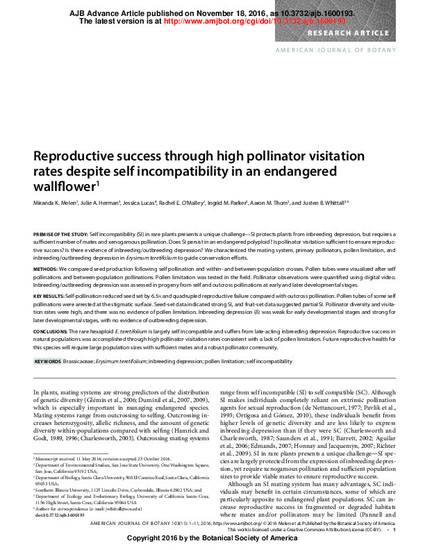
PREMISE OF THE STUDY: Self incompatibility (SI) in rare plants presents a unique challenge—SI protects plants from inbreeding depression, but requires a sufficient number of mates and xenogamous pollination. Does SI persist in an endangered polyploid? Is pollinator visitation sufficient to ensure reproductive success? Is there evidence of inbreeding/outbreeding depression? We characterized the mating system, primary pollinators, pollen limitation, and inbreeding/outbreeding depression in Erysimum teretifolium to guide conservation efforts.
METHODS: We compared seed production following self pollination and within- and between-population crosses. Pollen tubes were visualized after self pollinations and between-population pollinations. Pollen limitation was tested in the field. Pollinator observations were quantified using digital video. Inbreeding/outbreeding depression was assessed in progeny from self and outcross pollinations at early and later developmental stages.
KEY RESULTS: Self-pollination reduced seed set by 6.5× and quadrupled reproductive failure compared with outcross pollination. Pollen tubes of some self pollinations were arrested at the stigmatic surface. Seed-set data indicated strong SI, and fruit-set data suggested partial SI. Pollinator diversity and visitation rates were high, and there was no evidence of pollen limitation. Inbreeding depression (δ) was weak for early developmental stages and strong for later developmental stages, with no evidence of outbreeding depression.
CONCLUSIONS: The rare hexaploid E. teretifolium is largely self incompatible and suffers from late-acting inbreeding depression. Reproductive success in natural populations was accomplished through high pollinator visitation rates consistent with a lack of pollen limitation. Future reproductive health for this species will require large population sizes with sufficient mates and a robust pollinator community.

© 2016 Melen et al. Published by the Botanical Society of America.This work is licensed under a Creative Commons Attribution License (CC-BY).
Freely available online through the AJB open access option.